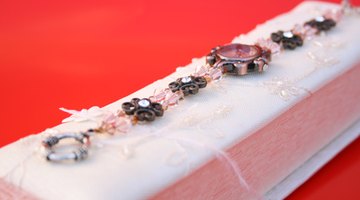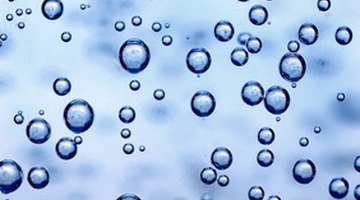Ingredients in Jewelry Cleaner
Spending significant amounts of money on jewelry is an investment. Like many other tangible assets, there is maintenance required to protect and showcase your property. One example of this is jewelry cleaning. Most jewelry stores offer professional cleaning of your jewelry.

There are also many homemade recipes for jewelry cleaning. In both cases, the owner must be careful of the ingredients used in cleaning. Some chemicals used in jewelry cleaning can be harsh and could permanently damage your jewelry.
Professional Jewelry Cleaners

Professional jewelers employ the use of specialized chemical solutions to clean jewelry. Most cleaners are primarily water (80 to 90 percent) with lower concentrations of active ingredients. Past ingredients included D-limonene and terpenes, which were advertised as natural citrus cleaners. However, these ingredients are being investigated as carcinogens and are no longer used commercially. Current professional cleaning products use strong chemicals, but in extremely low concentrations. It is important to note that the use of any jewelry cleaner on lower quality or faux gemstones and metals could permanently damage the piece.
Strong Alkaline Ingredients

Alkaline ingredients (called bases) are components with a very high pH, which is a measure of the acidity or alkalinity of a solution with a scale from 0 to 14. Pure water has a pH of 7.0. Acids are 0 to 7, and bases are 8 to 14. Strong bases and acids in jewelry cleaners can be a health hazard as well as damaging to the metals. Some commercial jewelry cleaners use sodium metasilicate or ammonium hydroxide. Both of these ingredients are strong bases, but are used in only small concentrations.
Surfactants and Quick Drying Agents

In addition to strong alkaline ingredients, jewelry cleaners can include surface active agents (surfactants) that remove the dirt and oils from the piece and allow them to be washed away with water. Surfactants used in jewelry cleaning applications are mild and do not create many suds or residues. Drying components such as butoxyethanol or isopropyl alcohol are used to dry the jewelry once it is removed from the cleaning solution.
Homemade Ingredients

Depending upon the gemstones and precious metals in the piece of jewelry, caution should be taken when preparing and using homemade jewelry cleaners. Simple alcohols such as isopropyl alcohol (rubbing alcohol) can be used to remove most oils and greases from the jewelry. Dirt can be removed using small amounts of dish detergent in water. Dish detergent is mild, has surfactants for cleaning, and is safe for hands and skin.
Writer Bio
Brian Baer has been writing since 1982. His work has appeared on Web sites such as eHow, where he specializes in technology, management and business topics. Baer has a Bachelor of Science in chemical engineering from the University of Arkansas and a Master of Business Administration from the University of Alabama, Huntsville.
Photo Credits
- jewelry image by Julija Sapic from Fotolia.com
- jewelry image by Julija Sapic from Fotolia.com
- Jewels image by Vanessa van Rensburg from Fotolia.com
- chemistry image by david hughes from Fotolia.com
- Clean water and water bubbles in blue image by Suto Norbert from Fotolia.com
- cleaning and sanitation products studio isolated image by dinostock from Fotolia.com
More Articles



